
Observations of Madeira, the island, did not begin for me in the mid-1990’s as did my early tasting adventures with the eponymous adult beverage. It took another dozen years before I was finally able to visit the island in person. My tour business partner Mario Ferreira and I began hosting Portuguese wine tours in 2005, specializing in Porto, Gaia and the splendor that is the Douro River Valley.
The following year, we decided to diversify our portfolio by adding wineries in Funchal, Câmara de Lobos, Seixal and various other parts of Madeira. We set off on an exploratory trip, to discover the island and its tourism infrastructure and destinations. I also had an added personal agenda; as it was my mission as a Terrantez fanatic, to try lobby as many of the remaining owners/managing directors to consider planting new vines and thereby saving my favorite grape from extinction. At the time, there were practically no Terrantez vines left at all on the island.
Henriques & Henriques was run by the affable and brilliant John Cossart at the time, and we visited with him and learned a lot about the island, its vineyards, export markets, and tourism opportunities. I distinctly remember our discussion on the Terrantez topic. He explained why it made little to no commercial sense to begin replanting the fickle grape variety. First, its thin skin made this cultivar as susceptible to rain and rot, as Pinot Noir. Cossart quipped, “Why bother to invest in a grape with such a difficult existence?” At the time, Henriques & Henriques had the single largest vineyard on the island, and it was by no means large, but then again, the average parcel of any vines on the island today, equates to just .3 hectare, equivalent to ¾ of an acre.
The island consists of a patchwork of grape parcels, small in size, and interspersed with the far more widely planted and financially lucrative crop of bananas. The farmers have sold their grapes to the Madeira companies who export, based on handshake agreements and little has changed over the past four centuries. At the peak between 1786 and 1790 there was 35 British owned Madeira firms and 21 individual shippers. Today there are more than 1,700 grape growers, (*IVBAM, Cadastro Viticola, 2020/2021) in Madeira, but surprisingly, only two of the remaining eight exporters on the main island, own a single vineyard; and the island contains 7 distinct micro-climates. The majority of the big companies currently purchase grapes from 200-700+ of the island’s growers.
After discussions with the remaining companies in 2006, it was depressing to learn that none felt there was a strong future for Terrantez. While by no means an expert at the time, I loved the grape and had been fortunate to try quite a few bottles from prior centuries. These Terrantez were astonishing in terms of sheer complexity, in aromatic terms, and depth and diversity of flavor characteristics and the textural pleasure offered by this varietal. It was not quite the chameleon like Tinta Negra, which can span from dry (seco) to sweet (doce). But the residual sugar level of Terrantez can vary between Verdelho and Bual, a respectful range as well.
During an historic tasting of Terrantez co-organized with Mannie Berk in 2012, with 20 epic and distinctive pre-Phylloxera bottlings of Terrantez; a half dozen from the 18th century and a few “last bottles on earth” … I literally had an epiphany. That day, I fully grasped the awe-inspiring nature of the Terrantez grape’s ability to drink amazingly well even from the mid-point of the 1700’s. It was the single best wine tasting event in my lifetime … and that is saying a mouthful!
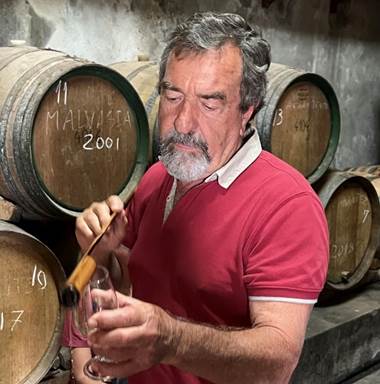
There are only a few dozen Terrantez growers on the island, total hectares of Terrantez are <6, representing only 1.4% of all 407.7 ha. of grapes in Madeira. Mario Fernandes, (in photo) took my 2006 urgings to heart, after I saw his six remaining Terrantez vines. In 2010, he planted 500 new vines and a few years ago he added another 250. He’s the co-owner and winemaker at an ancient and celebrated vineyard known as Fajã dos Padres. Any serious Madeira enthusiast will recognize this name, (literally the Romanée Conti of Madeira, not just due to the property’s propensity for producing some of the greatest Terrantez in recent centuries, but because Fajã dos Padres is also the place where the very last Malvasia Candida vine once survived.

* Potencial Vitícola 2020/2021 – Thank you Rubina Vieira, IVBAM Educator for providing this graph!
There’s no question this Candida clone produces extraordinary grapes, arguably the finest Malvasia grapes in the world, and this singular Fajã vine was propagated before its recent demise, and its offspring have now begun to flourish. Along with Terrantez, Malvasia Candida has a relatively bright future after nearly facing imminent extinction. My sincere thanks to Mario Fernandes, who Madeira wine history, should long remember!
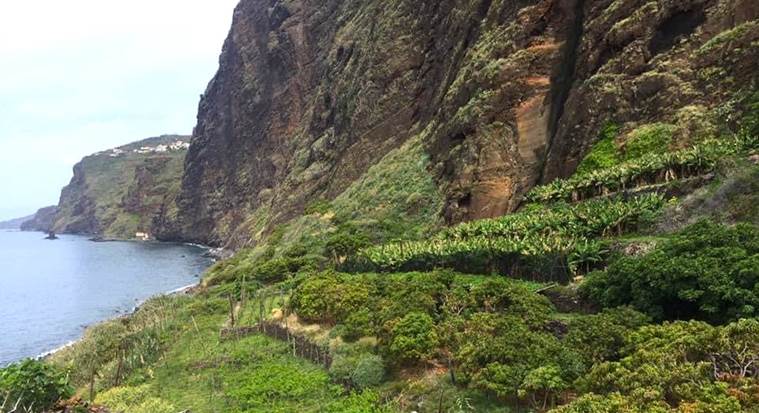
One parcel of the historic Fajã dos Padres vineyard, in very close proximity to the Atlantic Ocean.
It is now time to look at Madeira more broadly. What other wine on earth could possibly survive being left in the trunk of a car for a month during the heat of summer, and then drink beautifully a couple of days later? The Kryptonite-like qualities that would destroy every other wine known to mankind … oxidation and heat … have virtually no negative effect on bottles or casks of Madeira. This superpower should be exploited, right?
It is for this reason; I have never quite understood why the restaurant industry has not more broadly embraced Madeira. There are so many great reasons for featuring Madeira prominently on wine lists and its inclusion on back bars. Even served chilled at pool bars and night clubs.
Once a bottle of Madeira is opened, like liquor, it can last for years and drink well and remain fresh. This is a major consideration when offering dessert wines by the glass. But possibly even more importantly, IF Sommeliers and Executive Chefs begin to collaborate and wrap their heads around the potential of Madeira’s food pairing possibilities, it seems to this former restaurant pro, it should be a no-brainer. One other way for Somms (and bartenders) to embrace Madeira, is for use in cocktails. That is what reasonably priced Rainwater, as well as 3, 5 and 10 year old bottlings of Madeira would be perfect for and offer many new possibilities.
FOOD and MADEIRA
I could spend an entire chapter of a book, delineating the pairing possibilities on a grape-by-grape basis with the full spectrum of Madeiras. But quickly, in case you’d like to experiment in your home kitchen: from dry to off-dry Sercial and Verdelho, the plethora of dishes can range from soups, shellfish, to include charcuterie, a wide array of sushi and other Asian delicacies, fried chicken, or any roasted poultry, braised, grilled, smoked and roasted meats, grilled pineapples or peaches drizzled with balsamic, sauteed or grilled fish, a diverse assortment of cheese, pizza or panoply of pasta plates. That just begins to scratch the surface.
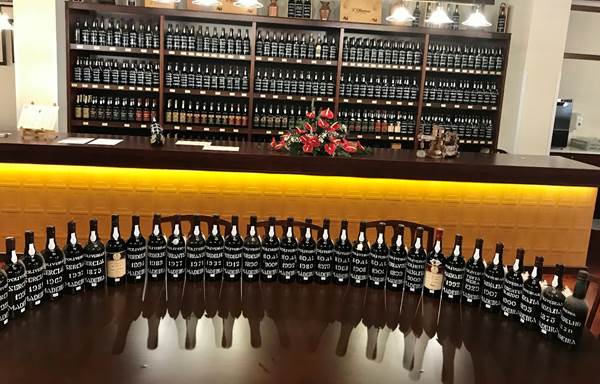
Our recent Madeirathon tasting at Pereira D’Oliveira Vinhos
The Madeiras that offer a bit more residual sugar, as in some Terrantez or Boal, then heading to the far sweeter end of the spectrum with Malmsey and Moscatel bottlings (and since gaining popularity in recent times, sweeter Tinta Negra bottlings) … they can complement the wide array of foods: from BBQ meats, cheeses better suited to these sweeter styles, dried or fresh stone and tropical fruits, plain/roasted/salted/candied nuts such as cashews, almonds, pecans, macadamia and walnuts to name a few, and virtually every delectable dessert dish imaginable. Both dry and sweet Madeiras also have their place in the kitchen, used in sauces and for sauteed foods. Exclusive restaurants in France utilize loads of Madeira for this purpose, and some Madeira producers even specifically bottle for this purpose, and some even add salt to those particular wines based on request, by chefs.
I have had some innovative meals in the USA, where chefs paired every course with a different grape of Madeira, or all dishes in the meal incorporated Madeira starting with the drier styles and progressing towards the sweetest ones to complement dessert creations. The various grapes and styles of Madeira can work well with nearly every type of culinary creation, no different than great table wines from Italy, Spain, France, America or anywhere else around the globe. It only requires imagination, the willingness to learn the intricacies of Madeira and a modicum of creativity.
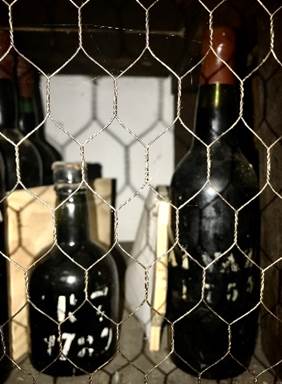
Bottles from the 1700’s held in cages at one producer’s adega as recently as October of this year.
I’d be remiss not to touch on what has been going on with the availability and prices of Madeira, with a quick look in the rear-view mirror and then a more current view and reality check. Madeira was the drink that American founders consumed with frequency. Legends and myths abound about the Declaration of Independence being signed and then toasted with Madeira, Betsy Ross sewing the early American flag and Francis Scott Key penning the lyrics to the national anthem, The Star Spangled Banner two years after, The War of 1812 … while both were allegedly consuming Madeira. And there are many more historic and folklored stories about this beverage. While the success of Port is easily attributable to the British, it is equally valid that Madeira gained a large part of its fame and fortune arguably due to America’s passion for this adult beverage, in a nascent country which embraced it, early and often.
Any consumer who has caught the enthusiasm for drinking fine Madeira in the past few decades, has noticed price and scarcity dynamics come into play. Bottles of early 1800’s gems that were often seen at just about every Madeira event, for example the 1834 Barbeito Malvasia, were had for well under $300 as recently as 25 years ago and maybe even a bit more recently than that. My first experience with that Madeira was in the early 1990’s and it was plentiful back then and literally I had it at least 15+ times within a decade. Nowadays, it can still be found, but it sells for $2,400-$3,300, as this once plentiful resource, has all but dried up. There are some decent very old stocks that still exist on the island or collectors hands in the USA and UK; but most are no longer for sale and next to impossible to obtain, unless one has very deep and personal connections with the old families who own, and occasionally put a few bottles on the auction market. Those oldies seen in cages, like the recent picture on the prior page, are held for very special events, and for the sake of having some available for future generations, in realization that these living dinosaurs can never be replaced.
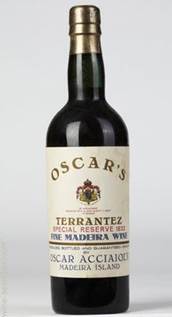
And along with diminishing availability, the prices have increased exponentially in recent decades. That gorgeous bottle of 1802 Oscar Acciaioly Terrantez (“Frasqueira” or what would be called Vintage Madeira if the Port trade had not trademarked the word “Vintage”) could be found at for about $2,500 around 15-18 years ago, but now costs upwards of $20,000 when a bottle or two are auctioned off by those that bought them for a song forty to fifty years ago, when most people had no idea what these were, their value, or how incredibly scarce they were even back then. The bottling on the left is easily considered by many to be the single greatest bottle of Madeira ever vinified and I’ve asked people that I know owned a handful of cases of it at one time.
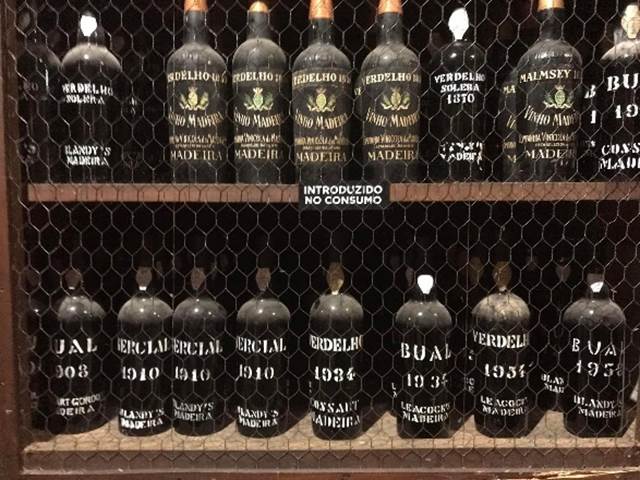
Recently seen, yet again, but not for sale
But some of the outstanding “cellar defenders” like the Broadbent 10 Year Old Malmsey or the Barbeito-Rare Wine Co. Historic Series Boal or Malmsey and others … which were very reasonably priced and affordable drinks, can still be found at prices considered relative bargains today. So shrewd Madeira shoppers can still do well, if they are willing to temper their enthusiasm and lower expectations regarding the ultra-expensive gems mentioned above.
Bottles that cost $500 just five years ago, now sell for over $1,000 in many … if not most cases. And I have not even begun to discuss what bottles generally fetch at auction, nowadays. It was unbelievable when bottles crossed into the rarified territory of $1,000-$2,500, about fifteen to twenty years ago. Now those benchmarks look ridiculously inexpensive, (in hindsight) as many of the greatest bottles have grown exponentially by a factor of 10x.
In our early tours of Madeira sixteen years ago and even as recently as 2014 and 2017 Madeirathon Tours, we were able to procure much older bottles, from the last mid-point or last quarter of the 19th century and early 20th at what were considered reasonable prices. These were what we paid the producers to allow our groups to have historic if not epic tastings. But in the past half decade, those same prices are now charged for bottles from the 1950’s-late 1970’s bottlings. But truth be told, those aforementioned older bottles are either held back entirely by the producers, not wanting this generation to plow through all remaining great and historic bottles. Serious collectors or those that join us to seek out some of those types of bottle that were plentiful, have had to be happy with younger bottles and most are from the 1930’s to 1960, but there are still the rare 1850-1890 bottles that one can find at one or two sources.
With tourism flourishing at levels never seen before, who can blame the producers for protecting their heritage wines? But it certainly makes putting together compelling tasting lineups for guests far more difficult. And I believe that in the next few years, many from the 1950’s and 1960’s will be ever more challenging to come across at all. I have seen some of our guests buy up the last of “great bottles” from as recent as the 1970’s earlier this year. So it is likely that the remaining gems will either be locked away or sold at prices that continue to skyrocket.
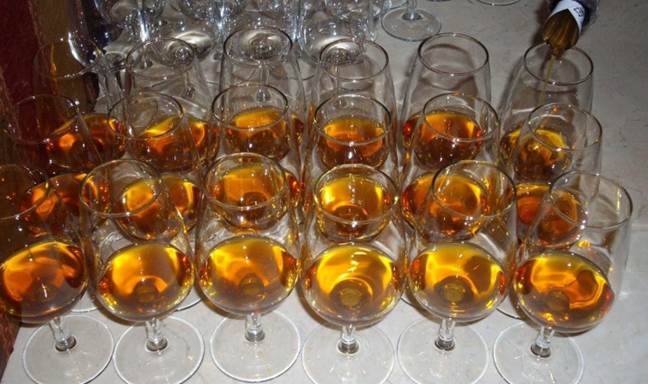
Wine consumers new to Madeira often times have expectations that are out of synch with these new realities. To maintain their older stocks of bottles, really the only two tools available to the half dozen older Madeira exporters have in their quiver are to dramatically increase their prices or completely stashing bottles away for the future. I do not have solutions for those looking to buy the oldies unless they are lucky with the few remaining old bottles that can be found at companies like The Rare Wine Co. or when a few retailers that purchased old bottles long ago, still have them sitting in obscurity on their shelves, and rarely those miraculous finds do still happen, but not for long.
Many of the oldest casks on the island have already been bottled, (D’Oliveiras 1850 Verdelho as just one example. While new categories have emerged to fill the void, relative bargains can still be had when seeking to enjoy Madeira nowadays. Categories such as ‘Colheita’ and even the newest category of “50 Year Old” bottlings have emerged which represent relative best buys, if one is able to look away from finding the 1863 Blandy’s Malvasia (Solera), or the Welsh Brothers, Barbeito and/or Leacock’s Bual bottlings from the same year. So temper expectations and feel very good about yourself when able to win an older bottle or lote of Madeira bottles, at auctions in the future. These bottles will not be found 10-20 years from now, and if they are … one will have to pay prices beyond what common sense would dictate. As an aside, the bottle displayed below, disappeared this year, a perennial favorite of mine and slightly less than 600 liters remain in one single cask. And this is just one example of a gem from 1983. Go figure!
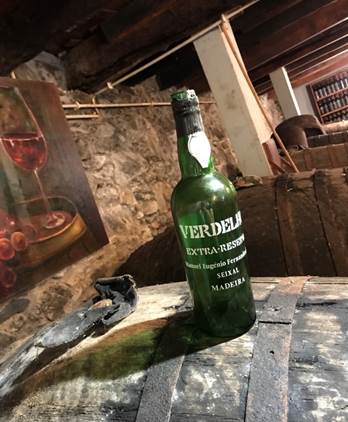

Leave A Comment
You must be logged in to post a comment.